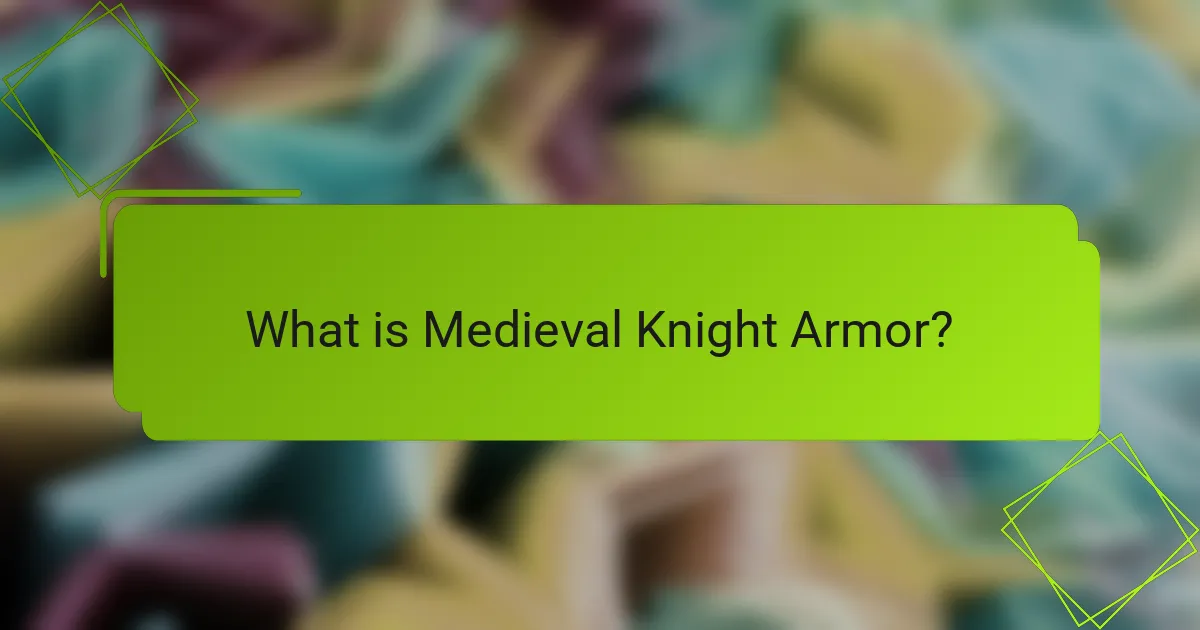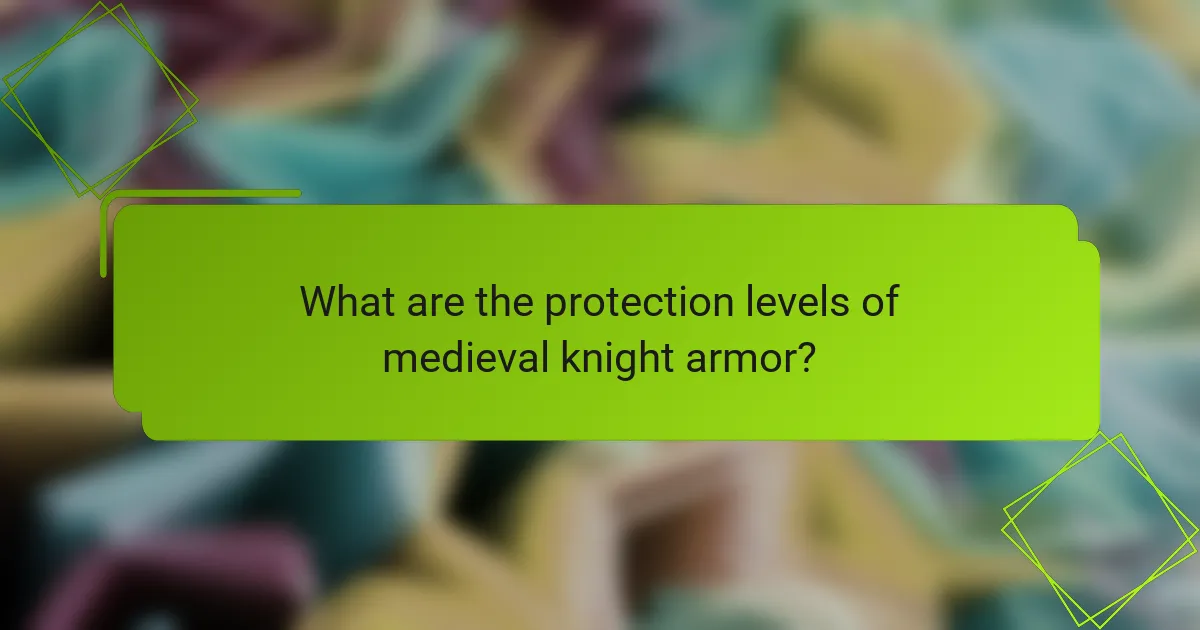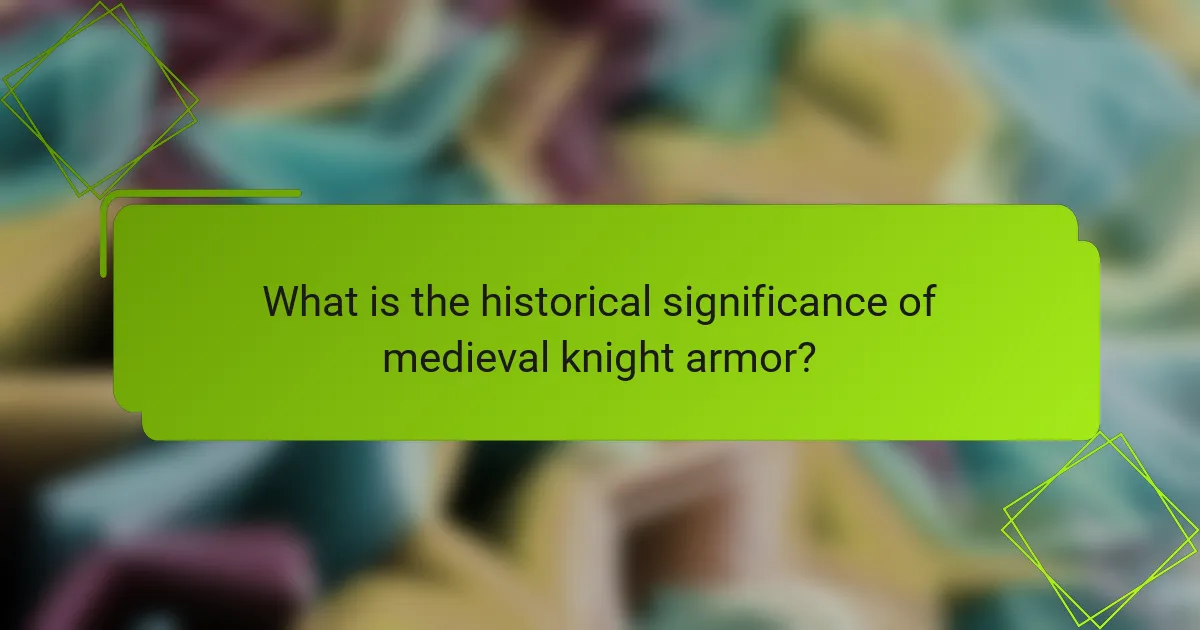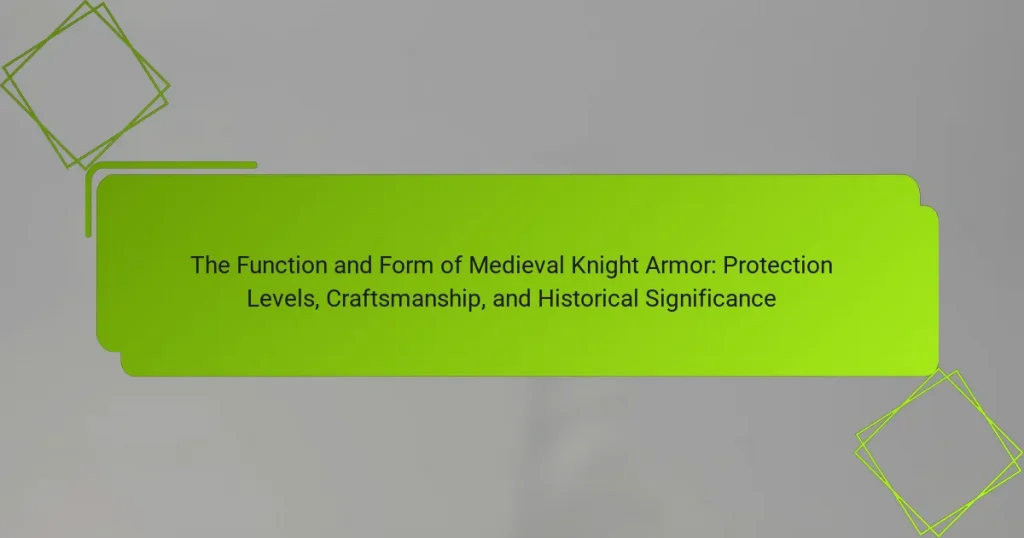Medieval knight armor is protective gear worn by knights during the Middle Ages, primarily designed to shield them from various weapons. This armor evolved over centuries, incorporating materials such as chainmail and plate armor, each serving distinct functions to enhance mobility and protection. Key components include helmets, breastplates, gauntlets, and greaves, all custom-fitted for individual knights to ensure effectiveness in combat. The craftsmanship involved in creating this armor reflects advancements in metallurgy and design, while also symbolizing a knight’s social status and adherence to the chivalric code. Surviving examples of medieval armor provide valuable insights into the culture, warfare strategies, and technological progress of the time.

What is Medieval Knight Armor?
Medieval knight armor is protective gear worn by knights during the Middle Ages. It typically consists of various metal plates and chainmail designed to shield the wearer from weapons. Armor evolved over centuries, adapting to changes in warfare and weapon technology. Key components include helmets, breastplates, gauntlets, and greaves. Each piece serves a specific function to enhance mobility and protection. Historical records indicate that armor was custom-fitted to individual knights for optimal effectiveness. The craftsmanship involved in creating armor was highly skilled, often involving blacksmiths and artisans. This gear played a crucial role in the social and military status of knights during the medieval period.
How did medieval knight armor evolve over time?
Medieval knight armor evolved significantly from the early Middle Ages to the late medieval period. Initially, armor consisted of simple leather and chainmail for basic protection. By the 12th century, plate armor began to emerge, providing better defense against weapons. The introduction of full plate armor in the 15th century offered comprehensive coverage for knights. This evolution was driven by advancements in metallurgy and changes in warfare tactics. Knights required more effective protection as weaponry became more powerful. The design of armor also became more sophisticated, incorporating articulated joints for better mobility. Historical examples include the transition from the hauberk to the knightly suit of armor. This progression reflects both technological innovation and the demands of combat.
What were the key historical influences on the design of knight armor?
The design of knight armor was influenced by military needs, technological advancements, and cultural factors. The evolution of warfare required armor to provide better protection against weapons like swords and arrows. Innovations in metallurgy allowed for stronger, lighter materials to be used in armor construction. The rise of heavy cavalry in the Middle Ages necessitated designs that could withstand blunt force impacts. Additionally, regional styles emerged, reflecting local customs and available resources. Armor also served a symbolic purpose, showcasing the status and wealth of the knight. Historical texts, such as treatises on warfare, provide evidence of these influences on armor design.
How did armor styles differ across various regions?
Armor styles differed significantly across various regions due to cultural, environmental, and technological factors. In Europe, plate armor became predominant during the late Middle Ages, characterized by its articulated plates that provided flexibility and protection. In contrast, Japanese samurai armor, known as “yoroi,” utilized lacquered leather and metal, emphasizing mobility and traditional aesthetics.
The Middle Eastern armor often featured chainmail and lamellar designs, suited for the region’s climate and combat styles. African armor varied widely, with some regions utilizing shields and leather, while others incorporated metal components influenced by trade.
These regional differences highlight how local resources and warfare needs shaped armor design. Historical records indicate that the evolution of armor was closely tied to the specific threats faced by each culture, leading to diverse styles and functionalities.
What are the main functions of medieval knight armor?
The main functions of medieval knight armor are protection, mobility, and intimidation. Protection is the primary function, safeguarding knights from weapons and projectiles in battle. Armor was designed to absorb and deflect blows. Mobility ensured that knights could move freely while wearing their armor. This balance allowed them to engage effectively in combat. Intimidation served as a psychological advantage on the battlefield. The imposing appearance of armor could deter enemies. Historical evidence shows that well-crafted armor increased a knight’s survival chances in combat. Different types of armor provided varying levels of protection, adapting to the evolving nature of warfare.
How does knight armor provide protection in battle?
Knight armor provides protection in battle by covering the body with a series of interlocking plates. These plates are made from materials like steel, which can withstand significant impact. The design of the armor distributes force across a wider area, reducing the likelihood of injury. Additionally, armor often includes features like a helmet to protect the head and a breastplate to shield vital organs. Historical records indicate that fully armored knights had increased survival rates during combat. For instance, the use of plate armor became prevalent in the 15th century, significantly enhancing battlefield protection. Overall, knight armor was essential for minimizing injuries from weapons like swords and arrows.
What role does mobility play in the effectiveness of armor?
Mobility is crucial for the effectiveness of armor. It allows the wearer to maneuver quickly in combat. Enhanced mobility enables knights to evade attacks and reposition themselves strategically. Heavy armor can restrict movement, making it challenging to fight effectively. Conversely, lighter armor offers better agility but may sacrifice some protection. Historical accounts show that successful knights often balanced weight and mobility. For instance, the evolution of plate armor improved mobility while maintaining defense. This balance was essential during battles, where quick reactions were vital for survival.
What materials were used in the construction of knight armor?
Knight armor was primarily constructed from metal, leather, and textile materials. Steel was commonly used for plates, providing durability and protection. Iron was also utilized, especially in earlier designs. Leather served as a flexible component, often used for straps and padding. Chainmail, made from interlinked metal rings, offered additional defense against slashing attacks. Textile materials, like linen and wool, were used for undergarments to enhance comfort and absorb sweat. Historical records indicate that these materials were essential for creating effective armor during the medieval period.
What are the advantages and disadvantages of different armor materials?
Different armor materials have distinct advantages and disadvantages. Steel armor offers high durability and excellent protection against slashing and piercing attacks. However, it can be heavy and restrict movement. Leather armor is lightweight and allows for better mobility, but it provides less protection against heavy weaponry. Chainmail offers good flexibility and can absorb impact, but it is less effective against blunt force trauma. Plate armor provides comprehensive coverage and is highly protective but can be cumbersome and expensive to produce. Each material’s effectiveness varies based on the combat scenario and the type of weapon used.
How did craftsmanship affect the quality of armor?
Craftsmanship significantly influenced the quality of armor. High-quality craftsmanship ensured precise fitting and effective protection. Skilled artisans used superior materials, enhancing durability and strength. Attention to detail in design improved mobility while maintaining defense. Historical records show that well-crafted armor could withstand blows from weapons. For example, the armor of renowned knights often showcased intricate designs and robust construction. This craftsmanship led to a balance between aesthetics and functionality. Ultimately, the quality of armor directly correlated with the skill of the craftsmen who produced it.

What are the protection levels of medieval knight armor?
Medieval knight armor provided multiple levels of protection, primarily categorized into layers and materials. The most common types included chainmail, plate armor, and padded garments. Chainmail offered flexibility and protection against slashing attacks. It was made of interlinked metal rings. Plate armor provided superior defense against blunt force and piercing attacks. It consisted of large metal plates covering vital areas. Padded garments, worn underneath, absorbed impact and prevented chafing.
The effectiveness of armor varied by design and thickness. Full suits of plate armor could withstand sword strikes and arrows. Historical records indicate that knights were often able to engage in combat without severe injury due to their armor. The combination of these protective layers was crucial for a knight’s survival in battle.
How is protection level measured in knight armor?
Protection level in knight armor is measured by its ability to absorb and deflect impacts from weapons. This is evaluated through various tests, such as ballistic testing and historical combat scenarios. The thickness and material of the armor significantly influence its protective capabilities. For example, steel armor typically offers greater protection than leather. Additionally, the design and coverage area of the armor are crucial factors. Full plate armor provides more protection than chainmail due to its solid construction. Historical records indicate that well-crafted armor could withstand blows from swords and arrows effectively. Thus, the measurement of protection levels combines material properties, design, and historical performance evidence.
What specific threats does knight armor protect against?
Knight armor protects against various threats including melee attacks, projectiles, and blunt force trauma. Melee attacks from swords and axes are mitigated by the metal plates and chainmail. Armor is designed to deflect or absorb the impact of these weapons. Projectiles such as arrows and bolts are countered by the thickness and layering of armor. Historical examples show that plate armor was effective against arrows, particularly during the 14th century. Blunt force trauma from impacts, like those from maces or war hammers, is reduced due to the rigid structure of the armor. This effectiveness is evidenced by accounts of knights surviving battles with minimal injuries. Overall, knight armor serves as a comprehensive defense against multiple combat threats in medieval warfare.
How did the thickness of armor plates impact protection levels?
The thickness of armor plates significantly impacted protection levels by enhancing their ability to absorb and deflect blows. Thicker plates provided greater resistance against weapons, reducing the likelihood of [censured]. For instance, armor plates of 1 inch thickness could withstand arrows and swords more effectively than thinner variants. Historical evidence shows that knights wearing thicker armor had higher survival rates in battles. The increased weight of thicker armor also influenced mobility but was often deemed necessary for enhanced protection. Thus, the balance between thickness and usability was crucial in medieval armor design.
What types of armor were commonly used by knights?
Knights commonly used several types of armor during the medieval period. The primary forms included chainmail, plate armor, and leather armor. Chainmail consisted of interlinked metal rings, providing flexibility and protection against slashing attacks. Plate armor featured large metal plates, offering superior defense against blunt force and piercing weapons. Leather armor was lighter and more flexible, often used for mobility. Historical records indicate that by the late 14th century, plate armor became the standard for knights, enhancing their battlefield effectiveness.
What is the difference between chainmail and plate armor?
Chainmail consists of interlinked metal rings, providing flexibility and moderate protection against slashing attacks. Plate armor, on the other hand, is made of large metal plates that cover the body, offering superior defense against blunt force and piercing attacks. Chainmail was commonly used in the early medieval period, while plate armor became prevalent during the late medieval era. Historical records show that chainmail can absorb and distribute impact but may not prevent [censured] from arrows or heavy blows. Plate armor’s solid structure effectively deflects projectiles and absorbs shock, making it more effective in battlefield scenarios. The transition from chainmail to plate armor reflects advancements in metallurgy and changes in combat tactics.
How did the design of helmets contribute to overall protection?
The design of helmets significantly enhanced overall protection for medieval knights. Helmets were crafted to absorb and deflect blows during combat. Their rounded shapes minimized the impact of strikes. Many helmets featured visors to protect the face while allowing visibility. These visors could be raised or lowered as needed. Additionally, materials like steel provided durability against weaponry. The weight distribution of helmets was optimized for comfort and stability. Historical records indicate that well-designed helmets reduced head injuries in battle. Thus, the design of helmets was crucial for ensuring the safety of knights in warfare.

What is the historical significance of medieval knight armor?
Medieval knight armor holds significant historical importance as it represents the evolution of warfare and social status. Armor was designed primarily for protection during battles, reflecting advancements in metallurgy and design. The transition from chainmail to plate armor marked a crucial development in combat effectiveness. This shift occurred around the 14th century due to changes in weapon technology, such as the crossbow and later firearms.
Armor also symbolized the chivalric code and the status of knights in feudal society. Elaborate designs and heraldry displayed a knight’s allegiance and achievements. The craftsmanship involved in creating armor showcased the skills of blacksmiths and armorers, contributing to local economies.
Additionally, surviving examples of armor provide insight into medieval culture, warfare strategies, and technological progress. Historical records indicate that specific armor types were used in different regions, highlighting variations in combat practices. Overall, medieval knight armor is a key artifact that reveals much about the societal structure and military practices of the time.
How did armor reflect the social status of knights?
Armor reflected the social status of knights through its design, materials, and craftsmanship. Higher-ranking knights wore armor made from expensive materials like steel and adorned with intricate decorations. This indicated their wealth and noble lineage. The quality of armor also demonstrated a knight’s access to skilled artisans. For example, the finest suits of armor featured personalized engravings and unique designs. Such details distinguished elite knights from their lower-status counterparts. Additionally, the weight and complexity of armor often signified a knight’s combat experience and reputation. Heavy, ornate armor was typically reserved for those of higher status, while simpler designs were common among lesser knights. Overall, armor served as a visible marker of a knight’s social standing in medieval society.
What symbols and designs were commonly used in knight armor?
Common symbols and designs used in knight armor included heraldic emblems, personal insignias, and religious symbols. Heraldic emblems often featured animals, such as lions and eagles, representing strength and nobility. Personal insignias identified individual knights and their families, often displayed on shields and surcoats. Religious symbols, like crosses, were common, reflecting the knight’s faith and moral code. These designs were not only decorative but also served to signify allegiance and status in medieval society. Historical records show that these symbols were crucial for identification in battle, as knights often fought alongside many others.
How did armor influence the outcomes of historical battles?
Armor significantly influenced the outcomes of historical battles by providing protection and enhancing combat effectiveness. It allowed soldiers to withstand blows from weapons, reducing casualties. For instance, during the Battle of Agincourt in 1415, English longbowmen targeted French knights, whose heavy armor slowed their movement and contributed to their defeat. The design of armor also evolved, with plate armor providing better mobility and defense compared to chainmail. This evolution allowed knights to engage more effectively in combat. Additionally, armor affected tactics; armies adapted their strategies based on the type of armor worn by opponents. The presence of effective armor often determined the balance of power on the battlefield. Overall, armor played a crucial role in shaping military engagements throughout history.
What lessons can be learned from the craftsmanship of medieval knight armor?
The craftsmanship of medieval knight armor teaches valuable lessons about design, functionality, and innovation. Each piece was tailored for specific combat scenarios. This customization ensured maximum protection while allowing mobility. The use of layered materials enhanced durability against various weapons. Techniques like tempering and polishing improved both strength and aesthetics. Historical records show that skilled blacksmiths were essential to this process. Their expertise resulted in armor that was both practical and symbolic of status. The evolution of armor reflects broader technological advancements in medieval society.
How can modern armor design benefit from historical techniques?
Modern armor design can benefit from historical techniques by incorporating traditional craftsmanship and materials. Historical armor, such as that used by medieval knights, often utilized layered construction for enhanced protection. This method disperses impact forces more effectively than single-layer designs.
Additionally, the use of specific metals and alloys in historical armor can inform modern material choices. For example, the use of tempered steel in medieval armor provided a balance of strength and flexibility.
Furthermore, studying historical designs can inspire ergonomic improvements in modern armor. Historical pieces were often tailored for mobility while maintaining protection. This balance is crucial for contemporary applications in military and law enforcement gear.
Research into historical battle outcomes also provides insights into effective armor design. Analyzing the effectiveness of different styles against various weapons can guide modern innovations. Overall, integrating these historical techniques can lead to more effective and functional modern armor.
What best practices can be applied to contemporary protective gear?
Contemporary protective gear should prioritize fit, material quality, and functionality. Proper fit ensures maximum protection and comfort during use. High-quality materials, such as Kevlar or carbon fiber, enhance durability and resistance to impact. Gear should also meet relevant safety standards, such as those set by ASTM or ISO. Regular maintenance and inspections are essential to ensure continued effectiveness. Additionally, incorporating ergonomic designs can improve mobility and reduce fatigue. Lastly, user feedback should guide design improvements for better performance.
Medieval knight armor is the primary entity of this article, which explores its function, craftsmanship, and historical significance. The article details the evolution of armor from simple leather and chainmail to advanced plate designs, highlighting the materials used and the craftsmanship involved. It examines the protective capabilities of armor against various combat threats, its impact on mobility, and how armor styles varied across regions. Additionally, the article discusses how armor reflected the social status of knights and influenced historical battles, providing insights into the technological advancements and cultural factors that shaped medieval warfare.




